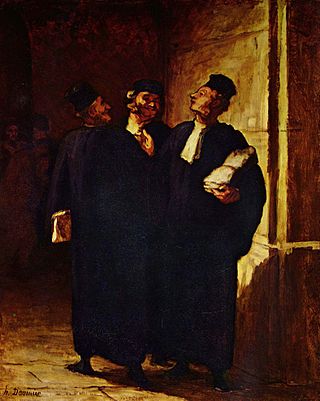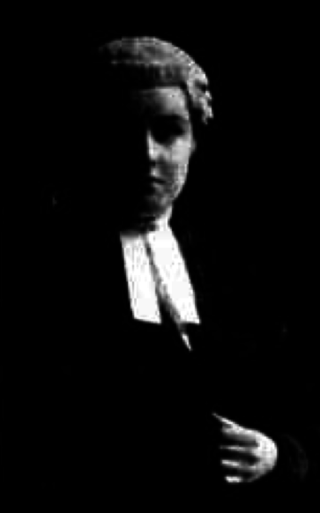Related Research Articles

A barrister is a type of lawyer in common law jurisdictions. Barristers mostly specialise in courtroom advocacy and litigation. Their tasks include taking cases in superior courts and tribunals, drafting legal pleadings, researching the law and giving expert legal opinions.

An advocate is a professional in the field of law. Different countries' legal systems use the term with somewhat differing meanings. The broad equivalent in many English law–based jurisdictions could be a barrister or a solicitor. However, in Scottish, Manx, South African, Italian, French, Spanish, Portuguese, Scandinavian, Polish, Israeli, South Asian and South American jurisdictions, "Advocate" indicates a lawyer of superior classification.

Legal education is the education of individuals in the principles, practices, and theory of law. It may be undertaken for several reasons, including to provide the knowledge and skills necessary for admission to legal practice in a particular jurisdiction, to provide a greater breadth of knowledge to those working in other professions such as politics or business, to provide current lawyers with advanced training or greater specialisation, or to update lawyers on recent developments in the law.
The call to the bar is a legal term of art in most common law jurisdictions where persons must be qualified to be allowed to argue in court on behalf of another party and are then said to have been "called to the bar" or to have received "call to the bar". "The bar" is now used as a collective noun for barristers, but literally referred to the wooden barrier in old courtrooms, which separated the often crowded public area at the rear from the space near the judges reserved for those having business with the court. Barristers would sit or stand immediately behind it, facing the judge, and could use it as a table for their briefs.

Admission to the bar in the United States is the granting of permission by a particular court system to a lawyer to practice law in the jurisdiction and before those courts. Each U.S. state and similar jurisdiction has its own court system and sets its own rules for bar admission, which can lead to different admission standards among states. In most cases, a person is "admitted" or "called" to the bar of the highest court in the jurisdiction and is thereby authorized to practice law in the jurisdiction. Federal courts, although often overlapping in admission standards with states, set their own requirements for practice in each of those courts.

In law, the bar is the legal profession as an institution. The term is a metonym for the line that separates the parts of a courtroom reserved for spectators and those reserved for participants in a trial such as lawyers.
A bar examination is an examination administered by the bar association of a jurisdiction that a lawyer must pass in order to be admitted to the bar of that jurisdiction.
Martha Angle Dorsett was the first woman admitted to the bar in the state of Minnesota.

A law school is an institution or professional school specializing in legal education, usually involved as part of a process for becoming a judge, lawyer, or other legal professional within a given jurisdiction.

The number of women in the United States judiciary has increased as more women have entered law school, but women still face significant barriers in pursuing legal careers.

Myra Colby Bradwell was an American publisher and political activist. She attempted in 1869 to become the first woman to be admitted to the Illinois bar to practice law, but was denied admission by the Illinois Supreme Court in 1870 and the United States Supreme Court in 1873, in rulings upholding a separate women's sphere. Bradwell had founded and published Chicago Legal News from 1868, reporting on the law and continued that work. Meanwhile, influenced by her case, in 1872 the Illinois legislature passed a state law prohibiting gender discrimination in admission to any occupation or profession.
An admission to practice law is acquired when a lawyer receives a license to practice law. In jurisdictions with two types of lawyer, as with barristers and solicitors, barristers must gain admission to the bar whereas for solicitors there are distinct practising certificates.

Mary Hall was the first female lawyer in Connecticut, and also a poet, a suffragist, and a philanthropist. In 1882, the Connecticut Supreme Court of Errors' decision to allow Hall to be admitted to the Connecticut Bar was the first judicial decision in the nation to hold that women were permitted to practice law.

Lelia Josephine Robinson was the first woman to be admitted to the bar and practice in the courts of Massachusetts in 1882.
Gwyneth Marjorie Bebb, OBE was an English lawyer. She was the claimant in Bebb v. The Law Society, a test case in the opening of the legal profession to women in Britain. She was expected to be the first woman to be called to the bar in England; in the event, her early death prevented that, and Ivy Williams was the first woman to qualify as a barrister in England, in May 1922.

Sarah Killgore Wertman, née Killgore was an American lawyer. She was the first woman to both graduate from law school and be admitted to the bar of any state in the United States, after graduating from the University of Michigan Law School and being admitted to the State Bar of Michigan in 1871.
Mercedes Deiz was an American lawyer. She became the first black woman admitted to the Oregon State Bar, and was also the first black woman to serve as a district court judge and the first to be elected as a county circuit court judge.

Auvergne Mary Doherty, M.A., B.A. was an Australian businesswoman, working in her family's cattle business. She was one of the first nine women called to the bar in England; Doherty was the first Western Australian woman called to the English Bar; she did not go on to practise law in England or Western Australia. Instead, Doherty took over her father's business when he died in 1935.
Minnie Anderson Hale was one of the first three female lawyers in Georgia.

Annie MacDonald Langstaff was a Canadian law student, legal activist, supporter of women's suffrage and an early woman aviator. Born in Ontario in 1887, she graduated from Prescott High School and then married in 1904. Her husband quickly abandoned her, leaving her a single mother. Moving to Montreal in 1906, she began working as a stenographer in the law office of Samuel William Jacobs, who encouraged her to study law. Finding no barriers to her admission, Langstaff enrolled at McGill University in 1911, graduating three years later as a Bachelor of Civil Law. On applying to the Bar of Montreal to practice, she was refused the right to take the examination.
References
- ↑ "WOMEN IN THE PROFESSION: 100 Years of Georgia Women Lawyers" (PDF). State Bar of Georgia Young Lawyers Division in the Profession Committee. 2016.
- ↑ Year: 1910; Census Place: Pinckneyville, Gwinnett, Georgia; Roll: T624_194; Page: 2A; Enumeration District: 0057; FHL microfilm: 1374207
- 1 2 "Mrs Mary Campbell Johnson was among the first women admitted to the bar In Georgia". The Atlanta Constitution. January 14, 1917. Retrieved 2019-08-27.
- ↑ Women lawyers' journal. 1971.